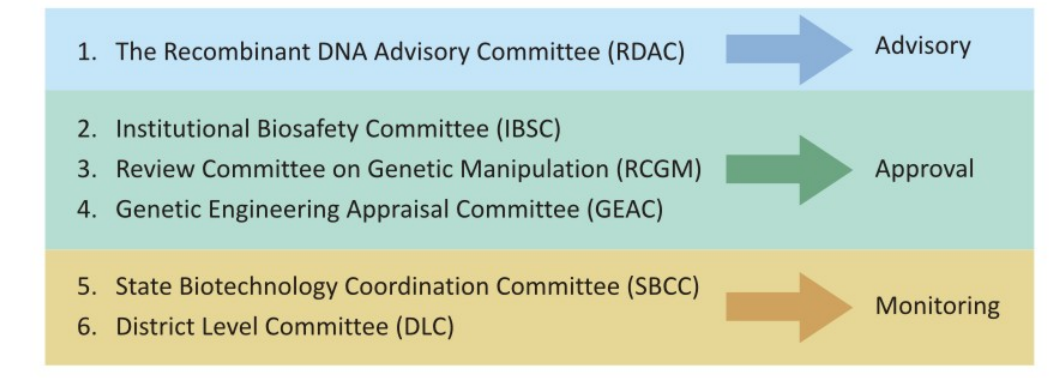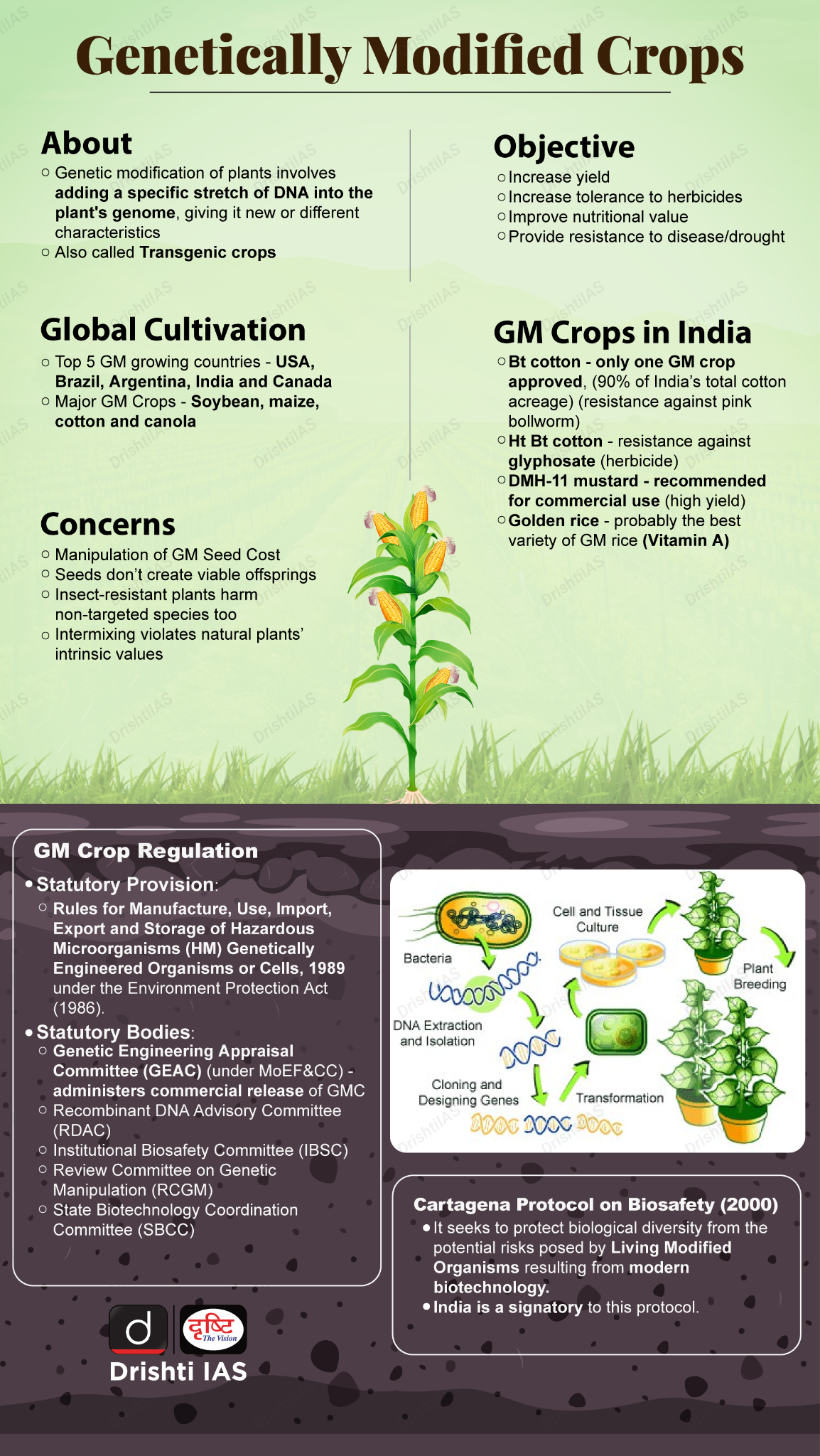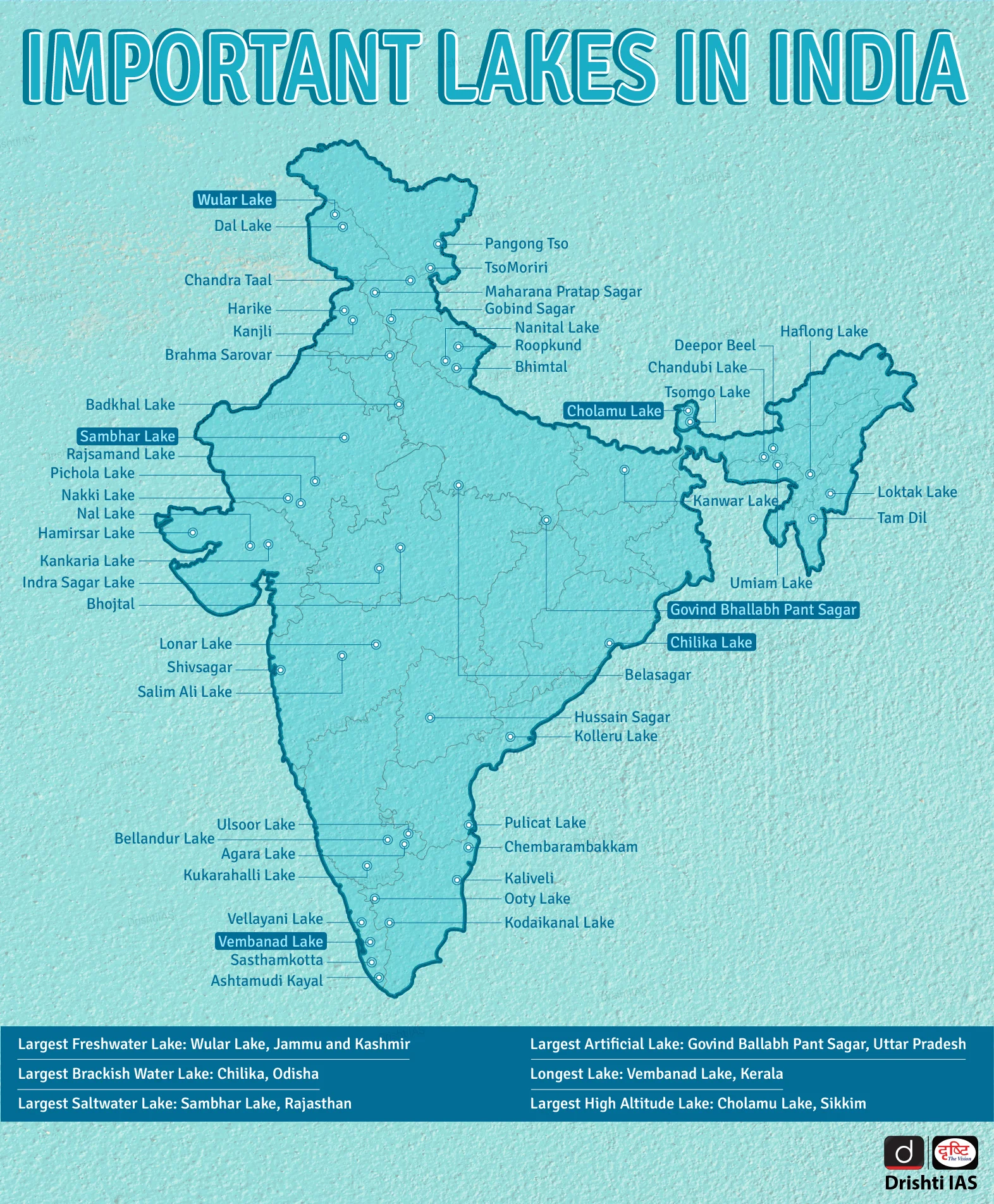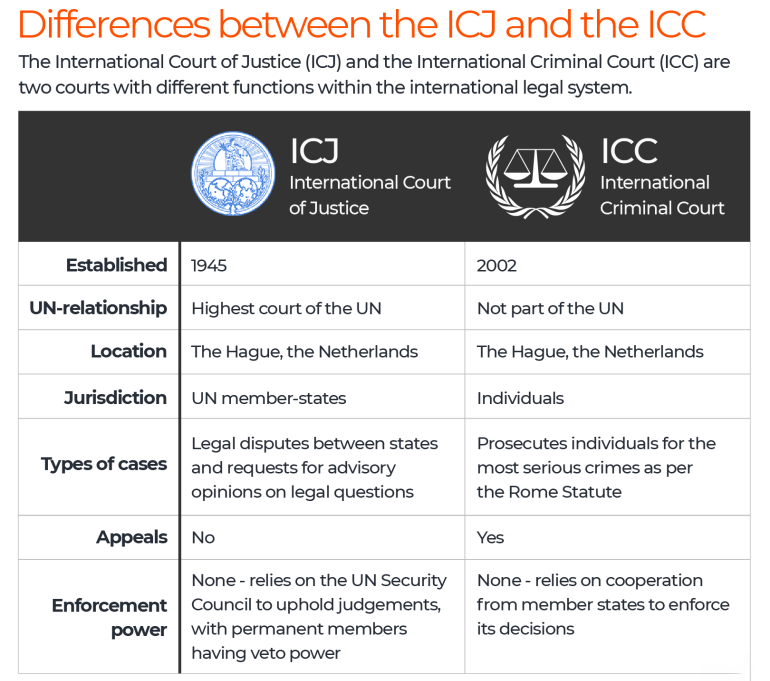Indian Economy
Exploring the Opportunities and Challenges of GM Crops
For Prelims: Genetically modified (GM) Mustard, Genetically Modified crops, Bt cotton, Drought-tolerant maize varieties, Golden Rice, C4 rice, Genetic Engineering Appraisal Committee, Environment Protection Act,1986, Intellectual Property Rights
For Mains: Regulatory Framework for GM Crops in India, Benefits and Issues Related to GM Crops
Why in News?
Amid ongoing trade negotiations, the US is pushing India to open its agriculture market to genetically modified (GM) crops. However, India has firmly stated that agriculture and dairy are 'sacrosanct red lines,' warning that allowing GM crop imports could threaten farmers' livelihoods and food safety.
What are Genetically Modified (GM) Crops?
- About: Genetically Modified (GM) crops are plants whose DNA is altered using modern genetic engineering technology to introduce or enhance desirable traits such as pest resistance, drought tolerance, or nutritional enhancement.
- Global Adoption: GM crops were first commercialized in the USA in 1994 with the Flavr Savr tomato, engineered to delay ripening.
- As per the International Service for the Acquisition of Agri-biotech Applications (ISAAA), by 2019, over 17 million farmers across 29 countries cultivated more than 190 million hectares of GM crops.
- Regulatory Framework in India: GM crops in India are regulated under the "Rules for the Manufacture, Use, Import, Export and Storage of Hazardous Microorganisms, Genetically Engineered Organisms or Cells" (Rules, 1989) under the Environment Protection Act,1986
- It provides a comprehensive regulatory framework for all activities involving GMOs, covering research and large-scale use, including manufacture, import, storage, sale, and export.
- They apply to genetically engineered organisms, related products, food items, and extend to new gene technologies like cell hybridization and genetic engineering, forming the basis of India’s biosafety regime.
What is the Status of GM Crop Adoption in India?
- Approved GM Crop: Bt cotton is the only genetically modified crop approved for commercial cultivation in India (since 2002). It now covers over 90% of India’s cotton area, around 12 million hectares.
- Bt cotton led to a 193% increase in production between 2002 and 2014, making India the second-largest global cotton exporter by 2011–12.
- It also contributed to higher farmer incomes and reduced pesticide use.
- Since 2015, cotton yields have declined from 566 kg/ha (2013–14) to around 436 kg/ha (2023–24).
- India now lags behind China and Brazil, with pest resurgence and absence of updated GM traits cited as key reasons.
- Pending GM Crop Approvals:
- Bt Brinjal: Approved by the Genetic Engineering Appraisal Committee (GEAC) in 2009, but placed under an ongoing moratorium due to public and political concerns.
- HT-Bt Cotton (Herbicide Tolerant): It is a herbicide-tolerant GM variant, is not approved for commercial use in India but is illegally cultivated in several states, including Gujarat, Maharashtra, Telangana, and Andhra Pradesh. It is estimated to cover 15–25% of total cotton acreage.
- GM Mustard (DMH-11): Granted environmental clearance in 2022, but its commercial release is on hold pending Supreme Court and regulatory approvals.
- Other Crops: GM variants of chickpea, pigeonpea, and sugarcane are at different stages of research, field trials, and regulatory deliberation.
What are the Key Benefits of Genetically Modified (GM) Crops?
- Enhanced Pest & Disease Resistance: GM crops like Bt cotton produce their own insecticides, effectively controlling pests like bollworms.
- Reduced pesticide use lowers costs, improves yields, and minimizes environmental harm, especially in pest-prone regions.
- Climate Resilience & Resource Efficiency: GM crops are developed to withstand drought, salinity, and heat, making them vital in the context of climate change.
- For instance, drought-tolerant maize in Kenya has improved yields in dry seasons.
- Additionally, GM crops like C4 rice and nitrogen-efficient variants aim to maximize output while using less water, fertilizer, and land.
- Nutritional Enhancement (Biofortification): GM technology enables the development of crops fortified with essential nutrients, addressing hidden hunger.
- Eg: Golden Rice (beta-carotene for Vitamin A), iron-rich rice, and zinc-enhanced wheat, targeting malnutrition in countries with limited dietary diversity and poor access to micronutrients.
- Reduced Post-Harvest Losses: GM crops with extended shelf life ( Flavr Savr tomato) help reduce post-harvest losses, especially in regions lacking refrigeration and cold storage.
- Herbicide-tolerant crops enable no-till farming, reducing soil erosion, carbon emissions, and preserving ecosystem health by minimizing pesticide use.
- Innovations in Medicine & Environmental Cleanup: GM crops are being researched for biopharming i.e producing vaccines and therapeutic compounds in plants like bananas and potatoes, potentially lowering healthcare costs and increasing access.
- Moreover, phytoremediation (use of plants to clean up environmental pollutants) using GM plants such as modified poplars helps absorb heavy metals and toxins.
What are the Key Challenges in GM Crop Adoption in India?
- Environmental and Health Concerns: GM crops may cause gene flow to wild species, leading to herbicide-resistant superweeds, while Bt crops can harm non-target insects and reduce biodiversity through monoculture.
- Health concerns include potential allergens, nutritional changes, and long-term safety highlighted by the StarLink corn incident (2000), where animal-feed-only GM corn entered the human food chain.
- Regulatory and Policy Constraints: India’s GM crop approvals are delayed due to regulatory opacity, prolonged moratoriums, and political hesitancy, even for scientifically cleared crops like Bt brinjal and GM mustard.
- Policies such as the Cotton Seed Price Control Order (2015) and mandatory tech transfer provisions have discouraged private R&D, hindering biotech innovation.
- Socio-Economic and Ethical Issues: There are concerns over market concentration, seed dependence, and high input costs for small farmers.
- Ethical issues such as “playing God”, food sovereignty, and community rights challenge public acceptance.
- Cases like Monsanto’s (US-based agricultural biotech company) enforcement of Intellectual Property Rights over GM seeds has led to global disputes over trait fees, seed sovereignty, and patentability, in India, the US and Canada.
- Coexistence, Contamination, and Illegal Cultivation: Coexistence of GM and non-GM crops poses challenges due to cross-pollination, risking organic certification and market access (Oregon GM wheat case, 2013).
- In India, HT-Bt cotton is illegally cultivated on up to 25% of cotton acreage, leading to biosafety risks and a black market for unregulated seeds.
- Resistance Development & Global Competitiveness: Overuse of GM traits has triggered pest and weed resistance, diminishing the effectiveness of Bt cotton and glyphosate-tolerant crops, requiring constant innovation.
- India’s declining cotton exports and turning net importer in 2024–25 signal a loss of global competitiveness due to delayed GM adoption and innovation stagnation.
What Measures Should be Taken for Responsible Adoption of GM Crops in India?
- Transparent, Science-Based Regulation: India should restructure its GM crop approval process to be time-bound, evidence-based, and managed by an independent authority with multi-stakeholder input.
- Ensure transparent field trials with public data access and independent oversight, along with long-term impact studies and regular ecological reviews to address biosafety and biodiversity.
- Strengthen PPP & Indigenous R&D: Promote collaborative biotech research through a Public-Private Partnerships (PPP) framework that balances innovation with public interest. Reform disincentives like the Cotton Seed Price Control Order (2015) and mandatory tech transfer norms.
- Support development of region-specific GM crops suited to Indian conditions and nutrition needs, with clear IPR-sharing mechanisms and increased funding for biofortified crop R&D.
- Inclusive and Responsible GM Crop Governance: Adopt farmer-centric policies ensuring access to quality seeds, training, insurance, and participation in decision-making, while preventing seed monopolies and preserving indigenous varieties through a national gene bank.
- Ensure coexistence of GM and non-GM crops via buffer zones and isolation distances, and implement robust GM labeling, public awareness, and strict enforcement against illegal cultivation.
- Global Standards & Nutrition Focus: Engage in international forums to harmonize biosafety norms and trade regulations. Prioritize biofortified GM crops like Golden Rice, iron-rich pulses, and zinc-enriched wheat to address micronutrient deficiencies. Launch pilot programs with health experts to demonstrate tangible health benefits.
Conclusion
India’s GM crop journey, marked by the success of Bt cotton and a prolonged policy deadlock reflects the tension between scientific potential and regulatory hesitation. In the face of climate challenges, nutritional deficiencies, and trade vulnerabilities, a science-driven, farmer-focused, and innovation-enabling approach is essential. As former PM Atal Bihari Vajpayee rightly said, “What IT is to India, BT is to Bharat”, a vision that must now be translated into action.
|
Drishti Mains Question How can genetically modified crops contribute to India’s food and nutritional security amid climate change and growing population? Evaluate the potential and risks associated with their widespread adoption. |
UPSC Civil Services Examination Previous Year Question (PYQ)
Prelims
Q1. Other than resistance to pests, what are the prospects for which genetically engineered plants have been created? (2012)
- To enable them to withstand drought
- To increase the nutritive value of the produce
- To enable them to grow and do photosynthesis in spaceships and space stations
- To increase their shelf life
Select the correct answer using the codes given below:
(a) 1 and 2 only
(b) 3 and 4 only
(c) 1, 2 and 4 only
(d) 1, 2, 3 and 4
Ans: (c)
Q2. Bollgard I and Bollgard II technologies are mentioned in the context of (2021)
(a) clonal propagation of crop plants
(b) developing genetically modified crop plants
(c) production of plant growth substances
(d) production of biofertilizers
Ans: (b)
Mains
Q. How can biotechnology help to improve the living standards of farmers? (2019)


Social Justice
World Population Day 2025 and India's Youth
For Prelims: World Population Day, Demographic Dividend, National Youth Policy 2014, Startup India, National Service Scheme (NSS), Unemployment, Pradhan Mantri Kaushal Vikas Yojana.
For Mains: Opportunities and challenges related to the youth population in India, Steps needed to empower them.
Why in News?
World Population Day, observed on 11th July, was established by the UN in 1989 to raise awareness about population issues and reproductive health rights.
- The theme for World Population Day 2025 is “Empowering young people to create the families they want in a fair and hopeful world,” which focuses on empowering youth to make informed choices about sexual and reproductive health.
What is the Status of Youth in India?
- Youth Demographic Profile: According to UNICEF, India has the world’s largest youth population, with 371 million people in the 15 to 29 age group.
- As per the Technical Group on Population Projections (2021), youth (15–29 years) accounted for 27.2% of the population in 2021, but are projected to decline to 22.7% by 2036.
- Demographic Significance: A large youth population enhances workforce participation and reduces dependency ratios, creating a demographic dividend for growth.
- Policy & Governance: Department of Youth Affairs, under the Ministry of Youth Affairs and Sports, is the nodal agency for youth-related policies and programs.
- Its twin objectives are personality development and nation-building.
- Evolution of Youth Policy:
- National Youth Policy, 1988: It was India’s first structured youth policy, stressing their role in national development and focusing on personality and skill development.
- National Youth Policy 2003: The National Youth Policy 2003, replacing the 1988 policy, defined youth as 13–35 years and aimed to promote patriotism, social justice, and national integration.
- National Youth Policy 2014: National Youth Policy 2014 replaced the 2003 policy, defines youth as 15–29 years, and envisions empowering them to realize their full potential and enable India to excel on the global stage. It outlined 5 key objectives and 11 priority areas.
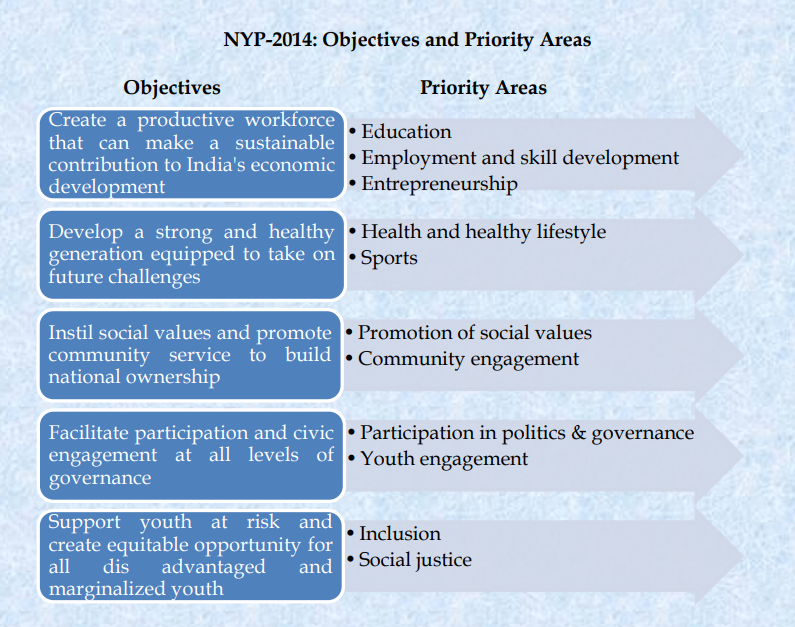
- National Youth Policy 2024: The Government has updated the National Youth Policy (NYP) 2014 and released a draft for NYP 2024, outlining a 10-year vision for youth development aligned with the Sustainable Development Goals (SDGs). Key highlights are:
- Roadmap to achieve youth development goals by 2030.
- Alignment with NEP 2020 to enhance career and life skills.
- Promotion of leadership, volunteering, and technology-driven empowerment.
- Focus on mental and reproductive health, sports, and fitness.
- Commitment to safety, justice, and support for marginalized youth.
What Opportunities Does India's Youth Population Present?
- Demographic Dividend Advantage: A youth-dominated population leads to a lower dependency ratio and more economically active citizens, which can boost GDP growth and per capita income.
- According to the World Bank and NITI Aayog, tapping this potential could add up to USD 1 trillion to India’s GDP by 2030.
- Innovation and Entrepreneurship: Driven by young entrepreneurs, India’s startup ecosystem has flourished, with the Startup India initiative playing a key role in promoting a youth-led culture of innovation.
- Global Workforce Advantage: India’s youth workforce can address global talent shortages in sectors like tech, healthcare, and engineering, while competitive labor costs position the country as a prime hub for manufacturing and services.
- E.g., Facing an ageing population, Germany and Japan are turning to India to fill its labour gap with skilled workers.
- Social & Cultural Influence: Indian youth are challenging stereotypes, advancing gender equality, and leading social change, while also expanding India’s soft power globally through films, music, and digital content.
- E.g., Youth-led movements like Pinjra Tod (Break the Cage) fight for women’s rights and freedom.
- Strengthening Democracy: Engaging youth through initiatives like the National Service Scheme (NSS) fosters civic awareness, leadership, and strengthens democratic accountability.
- E..g, Through Swachh Bharat Abhiyan, the Prime Minister mobilized youth as key drivers of cleanliness, behavioural change, and community leadership.
What are the Key Challenges Faced by Youth in India?
- Sexual & Reproductive Health Issues: India faces a high rate of unintended pregnancies (36%) and unmet reproductive goals (30%), with 23% experiencing both.
- Though child marriage has declined, it still exists at 23.3% nationally (NFHS-5).
- Gender Inequality: Patriarchal norms limit young women's autonomy in education, employment, and decision-making, with many lacking access to gender-sensitive workplaces, skills training, and financial independence.
- Mental Health Crisis: Youth are facing a mental health crisis marked by increasing stress, anxiety, and depression, along with a lack of accessible support and persistent stigma.
- In 2020-22, India recorded over 60,700 deaths due to suicide in the 15–29 age group, the highest in the world.
- Employment Crisis: A skill mismatch between education and job market needs has led to rising unemployment among educated youth, while many are forced into unstable gig economy jobs with limited benefits.
- Substance Abuse: Youth are increasingly vulnerable to drug addiction, driven by peer pressure and stress, with a lack of adequate rehabilitation facilities worsening the issue.
Government’s Initiatives Related to Youth
What Steps Should Be Taken to Empower Youth in India?
- Education Revolution: Promote critical thinking, creativity, and problem-solving by overhauling rote learning under the National Education Policy 2020, ensure digital literacy, and integrate vocational training into school curricula.
- Job-Linked Skill Development: Encourage apprenticeship opportunities in large companies under PM National Apprenticeship Promotion Scheme (PM-NAPS), launch upskilling missions in emerging sectors, and promote youth entrepreneurship through financial support.
- Healthcare Access: Establish accessible mental health support, ensure nutrition security through fortified meals, and enhance reproductive health services with free contraceptives in rural areas.
- Sports & Arts Infrastructure: Expand sports and arts infrastructure by strengthening rural training facilities, offering financial support to young artists, and promoting international cultural exchange programs for talented youth.
- Digital Empowerment: Bridge the digital divide by expanding internet access, building youth digital skills, and strengthening Digital India for inclusive digital growth.
Conclusion
India’s youth, the world’s largest, offer a transformative demographic dividend. To harness this potential, India must address challenges like unemployment, mental health, and gender gaps while boosting education, skills, and innovation. Strategic policies and inclusive growth can empower youth to drive India’s global rise, ensuring sustainable development and equitable progress.
|
Drishti Mains Question: Discuss the challenges faced by India’s youth in realizing their full potential. Suggest measures to convert these challenges into opportunities. |
UPSC Civil Services Examination Previous Year Question (PYQ)
Prelims
Q. Disguised unemployment generally means (2013)
(a) large number of people remain unemployed
(b) alternative employment is not available
(c) marginal productivity of labour is zero
(d) productivity of workers is low
Ans: (c)
Mains
Q. Most of the unemployment in India is structural in nature. Examine the methodology adopted to compute unemployment in the country and suggest improvements. (2023)
Q. The nature of economic growth in India in recent times is often described as jobless growth. Do you agree with this view? Give arguments in favor of your answer. (2015)


Facts for UPSC Mains
Initiatives Driving the Agricultural Growth in India
Why in News?
At the 16th Agriculture Leadership Conclave, the Union Minister of Commerce and Industry, highlighted major initiatives driving agricultural growth in India, focusing on soil health, credit access, digital innovation, and global trade.
What are the Initiatives Driving the Agricultural Growth in India?
- Minimum Support Price (MSP) Enhancements: MSP for several crops has seen significant increases, with pulses and oilseeds witnessing up to 98% higher MSP, directly benefiting farmers by ensuring remunerative prices for their produce.
- This policy aims to reduce farmers' vulnerabilities to market fluctuations and provide a financial cushion for their efforts.
- Soil Health Cards: Over 25 crore Soil Health Cards have been distributed. SHCs provide farmers with vital information on the health of their soil, guiding them on the type and amount of fertilisers to use, thereby improving crop yield and reducing over-reliance on harmful chemicals.
- Kisan Credit Card (KCC): Ensures wider access to crop loans and agricultural credit, supporting timely inputs and farm activities.
- As of 2024, there are 7.75 crore active KCC accounts with Rs 9.81 lakh crore in outstanding loans. Additionally, 1.24 lakh KCCs have been issued for fisheries and 44.4 lakh for animal husbandry activities.
- PM-KISAN Samman Nidhi: It is a Central Sector scheme with 100% funding from Government of India. Under the scheme an income support of 6,000/- per year in three equal installments will be provided to all land holding farmer families.
- The fund will be directly transferred to the bank accounts of the beneficiaries.
- As of 2024, 11.8 crore farmers have received financial assistance, making it one of the world’s largest Direct Benefit Transfer (DBT) schemes.
- e-NAM Integration: 1,400 mandis have been linked with the electronic National Agriculture Market (e-NAM) to improve transparency and price realisation.
- Fertiliser Subsidies: The Indian government budgeted over Rs 1.67 lakh crore– nearly 70% of India's agriculture budget–for fertiliser subsidy for the financial year 2025-26. Fertiliser subsidies are nearly 40% of India's total subsidy spending.
- Free Trade Agreements (FTAs): India’s FTAs with Australia, UAE, EFTA nations, and the UK have opened up new international markets for Indian agri-products.
- Digital Agriculture: Emphasis on AI, geospatial tech, weather forecasting, and vertical farming to modernize the farm sector.
- The Digital Agriculture Mission, approved in 2024, aims to build a farmer-centric digital ecosystem. It includes key components like AgriStack, which digitizes farmers' data, land, and crop details to ensure access to services like credit and insurance.
- Support to Farmer Producer Organisations (FPOs): The “Formation and Promotion of 10,000 FPOs” scheme, launched in 2020, aims to empower small and marginal farmers by collectivising them for better market access, reduced input costs, and improved incomes.
- As of February 2025, around 30 lakh farmers (40% women) have joined FPOs.
- FPOs are supported by multiple ministries including Agriculture, and Food Processing. A dedicated Credit Guarantee Fund ensures improved credit access, enhancing the viability of FPOs and boosting rural entrepreneurship.
- Agri-Exports and Value Addition: India’s agriculture and fisheries exports have reached Rs 4.5 lakh crore and hold the potential to scale up to Rs 20 lakh crore.
- Infrastructure and Irrigation: Investments in warehousing, cold chains, drip irrigation, and organic/natural farming practices are being scaled up.
- The Agricultural Infrastructure Fund (AIF) scheme, has been expanded to strengthen agrarian infrastructure through broader project eligibility, including viable community farming assets, integrated processing projects, and convergence with PM-KUSUM to promote clean energy.
- From 2015-2025, 96.97 lakh ha has been covered under micro irrigation through Per Drop More Crop (PDMC) Scheme, which includes 46.37 lakh ha under drip irrigation and 50.60 lakh ha under sprinkler irrigation.
India’s Agricultural Growth
- The agriculture & allied sector grew at 5% annually (FY17–FY23), with gross value added (GVA) share rising from 24.38% (2014-15) to 30.23% (2022-23). Agriculture income rose by 5.23% annually over the last decade.
- In FY24, India’s agri-food exports reached USD 46.44 billion (11.7% of total exports). The share of processed food rose from 14.9% in FY18 to 23.4% in FY24, highlighting growing value addition.
|
Drishti Mains Question: Critically assess India's integrated approach towards agricultural growth and increasing the farmers’ income. |
UPSC Civil Services Examination, Previous Year Question (PYQ)
Mains
Q. Explain various types of revolutions, took place in Agriculture after Independence in India. How have these revolutions helped in poverty alleviation and food security in India? (2017)
Q. Given the vulnerability of Indian agriculture to vagaries of nature, discuss the need for crop insurance and bring out the salient features of the Pradhan Mantri Fasal Bima Yojana (PMFBY). (2016)


Rapid Fire
Revival of Lotus in Wular Lake
After three decades of ecological dormancy caused by the 1992 flood, lotus flowers have once again begun blooming in Kashmir’s Wular Lake due to focused conservation efforts led by Wular Conservation and Management Authority (WUCMA).
- Lotus stems (locally called Nadru) couldn’t grow since 1992 as seeds were buried under heavy silt, but the rhizomes (creeping root stalks) survived deep below and sprouted once the silt was removed.
Wular Lake
- About: It is the largest freshwater lake in India and the second largest in Asia (after Lake Baikal in Siberia, Russia), located between Bandipora and Sopore in Jammu & Kashmir.
- Geography: It is located at the foothills of the Haramuk Mountain and is fed by the Jhelum River along with 25 other streams that feed it.
- It has a small island in its centre called the Zaina Lank, constructed by Zainul-Abi-Din, 8th sultan of Kashmir.
- Ecological Importance: In 1990, it was designated as a Wetland of International Importance under the Ramsar Convention.
- Geology: The basin of the lake was formed due to tectonic activity. It is also believed to be a remnant of the ancient Satisar Lake.
- Avian Fauna: Wular Lake is home to 56 bird species, 39 fish species, and over 20 types of plants.
- Notable migratory bird species found here include the White-bellied Heron, Pink-headed Duck, Baer’s Pochard, and the Kashmir Catfish.
Lotus (Nelumbo Nucifera)
- The lotus is a perennial plant with bowl-shaped flowers that have petals with an 8 to 12 inch diameter.
- It is an aquatic plant that thrives in nutrient-rich, murky conditions.
- It comes in shades of pink hues, yellow or white.
- It is recognised as the national flower of India. The lotus is a recurring motif of Hindu and Buddhist religions.
| Read More: Disputes Related to Indus Water Treaty |


Rapid Fire
International Criminal Court (ICC)
The International Criminal Court (ICC) has issued arrest warrants against Taliban leaders under Article 7(1)(h) of the Rome Statute for crimes against humanity, citing systematic gender and political persecution in Afghanistan.
International Criminal Court (ICC)
- About: ICC is the world’s first permanent international court established to prosecute individuals for the most serious crimes of global concern.
- It is headquartered in Hague, Netherlands and governed by the Rome Statute, which is the founding treaty of the ICC, adopted on 17th July 1998 and entered into force on 1st July 2002.
- Crimes Under ICC: The Rome Statute grants the ICC jurisdiction over 4 core international crimes- Genocide, Crimes against Humanity, War Crimes, Crime of Aggression.
- Jurisdiction & Mandate: The ICC prosecutes individuals, not states, for grave international crimes and cover crimes committed after 1st July 2002, the date the Rome Statute came into effect.
- It acts only when national jurisdictions are unwilling or unable to prosecute.
- The Court has jurisdiction in countries that are parties to the Rome Statute, or in non-member states if referred by the UN Security Council (UNSC).
- Parties to ICC:
- The Rome Statute has been ratified by 125 countries, including the UK and most European nations. Over 30 others have signed but not yet ratified the treaty.
- Afghanistan has been a member since 2003, while India, along with countries like the US, Israel, China are not parties to the ICC.
- India has raised objections due to concerns over sovereignty and the UNSC's referral powers within the Court's framework.
- Structure: The Presidency, Judicial Divisions, Office of the Prosecutor and the Registry are its 4 main organs.
- The Assembly of States Parties (ASP), consisting of representatives from member states, provides legislative oversight and ensures proper governance of the ICC.
- Enforcement: The ICC lacks its own police or enforcement mechanism and relies on voluntary cooperation of member states for arresting and surrendering accused individuals, freezing assets, and implementing its sentences.
| Read More: International Criminal Court (ICC), ICJ Proceedings: South Africa vs. Israel |


Rapid Fire
INS Nistar
The Indian Navy has inducted INS Nistar, its first indigenously built Diving Support Vessel (DSV), delivered by Hindustan Shipyard Limited (HSL), Visakhapatnam.
- A DSV is a specialized naval ship designed for underwater operations, including diver deployment, rescue missions, and submarine crew recovery.
INS Nistar
- Technical Specifications: It measures approximately 120 metres in length with a displacement of around 10,000 tonnes.
- It has an endurance of over 60 days at sea, is capable of supporting helicopter operations, and is equipped with a 15-tonne subsea crane to facilitate deep-sea recovery missions.
- Operational Capabilities: INS Nistar functions as the Mother Ship for Deep Submergence Rescue Vessels (DSRV) for submarine rescue, features a Dynamic Positioning System (DPS) for precise station-keeping, Side-Scan SONAR for seabed mapping, and supports search, recovery, diving, and salvage operations.
- Upon commissioning, the vessel will be inducted into the Eastern Naval Command to enhance capabilities in deep-sea diving and submarine rescue operations.
- The Indian Navy is organized into 3 major commands: Western, Eastern, and Southern Naval Commands.
- Upon commissioning, the vessel will be inducted into the Eastern Naval Command to enhance capabilities in deep-sea diving and submarine rescue operations.
- Legacy and Significance: INS Nistar continues the legacy of the original vessel acquired from the USSR in 1969 (decommissioned in 1989), significantly enhancing India’s submarine rescue capability, reinforcing strategic maritime autonomy, and strengthening India’s role as a net security provider in the Indian Ocean Region (IOR), which supports India’s SAGAR (Security and Growth for All in the Region) initiative.
| Read More: INS Nirdeshak |


Rapid Fire
Himalayas and Kashmir’s Climate Shift
A recent palaeobotanical study conducted by scientists from the Birbal Sahni Institute of Palaeosciences (BSIP), Lucknow, has revealed that the Kashmir Valley, currently known for its cool Mediterranean-type climate, was once a warm and humid subtropical region approximately 4 million years ago.
- BSIP was founded in 1946 to promote research in palaeobotany, and its foundation stone was laid by Prime Minister Jawaharlal Nehru in 1949. It received UNESCO support (1951–53) and became an autonomous body in 1969, funded by the Department of Science and Technology (DST).
Study on Kashmir’s Climate Shift
- About the Study: The study, based on a historic fossil leaf collection at BSIP, was prompted by a climatic mismatch between subtropical fossil specimens and Kashmir’s present-day temperate flora, leading to a fresh investigation into the valley’s ancient climate.
- Scientific Techniques Used: To reconstruct Kashmir’s palaeoclimate, the study used two key methods- CLAMP (Climate Leaf Analysis Multivariate Program), which analyzed leaf morphology (shape, size, margins) to estimate past temperature and rainfall, and the Coexistence Approach, which compared fossil taxa with their modern relatives to infer ancient climate ranges.
- Key Findings: Fossilized leaves from the Karewa sediments from Kashmir indicate that the valley once supported a lush subtropical forest.
- Many fossils resemble modern species from warm and humid climates, contrasting sharply with today's alpine and coniferous vegetation.
- The study attributes this climatic shift to the tectonic uplift of the Pir Panjal Range, part of the sub-Himalayan system.
- This uplift acted as a geological barrier, blocking the Indian summer monsoon, thereby reducing rainfall and transforming the region’s climate over geological timescales.
- Significance of the Study: The study enhances climate modelling by linking tectonic activity with ecosystem change, highlights the sensitivity of Himalayan ecosystems, and offers analogues for understanding monsoon dynamics, glacial melt, and topography interactions.
- It underscores the policy relevance of palaeoclimate research for biodiversity conservation, disaster preparedness, and sustainable development in fragile mountain regions.
| Read More: Himalayas More Prone to Extreme Weather Events |


Rapid Fire
Global HIV/AIDS Fight at Risk
According to the UNAIDS, a sudden halt in US funding for the President's Emergency Plan for AIDS Relief (PEPFAR) threatens to reverse decades of progress in the fight against HIV/AIDS.
- In January 2025, the US suddenly withdrew its USD 4 billion pledge, potentially leading to 4 million more AIDS-related deaths and 6 million new HIV infections by 2029.
- A breakthrough injectable drug, Yeztugo, shows 100% prevention efficacy — but the high price is keeping it out of reach for most low- and middle-income countries.
- PEPFAR, launched in 2003, aims at preventing Human Immunodeficiency Virus (HIV) infections, and saves lives.
- UNAIDS (Joint United Nations Programme on HIV/AIDS) is the UN's leading global agency dedicated to:
- Ending AIDS as a public health threat by 2030
- Coordinating HIV response across 11 UN agencies (e.g., WHO, UNICEF, World Bank)
- Advocating for equitable access to prevention, treatment, and care.
| Read More: US Agency for International Development |



